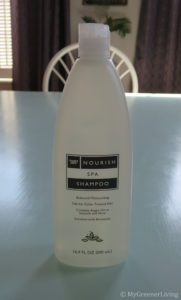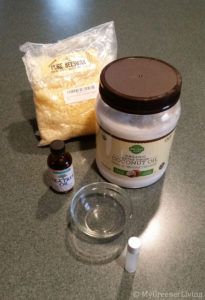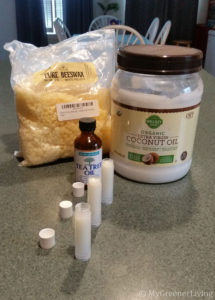When people learn about my blog and this lifestyle I often get the question, “What kind of shampoo do you use?” I like this question, because, after face and body moisturizer, shampoo was one of the first cosmetic products that I sought to replace with a safer (to me and to the environment) product.

Disclaimer: This post contains affiliate links. See my Disclosure Policy for more information.
It is likely that hair type has a lot to do with what type of shampoo works best. My hair is very fine, long, wavy, and blonde.
The beginning
Before I embarked on my environmentally conscious way of life, I was using the shampoos common in supermarkets and mass merchandisers, like Suave Daily Clarifying Shampoo. It got an Environmental Working Group (EWG) rating of 5 (on a scale of 1-10 with 1 being best). Among others, this shampoo contains Sodium Laureth Sulfate, fragrance, and artificial colors – all of which are ingredients I am avoiding. These items are known skin irritants as well as possible health risks. Once I bean researching ingredients in my products, I knew this shampoo had to go.
Trials and Errors
Per my usual, I turned to Pinterest for homemade shampoo recipes that used only safe and natural ingredients. I tried three different types of homemade shampoos.
No-Poo method
The no-poo method involves “washing” hair with baking soda, and rinsing with vinegar. Some people sweat by it, but after trying this for 2 weeks, I felt like I hadn’t washed my hair in 2 weeks – it felt disgusting, dirty. I couldn’t handle it, and I was also concerned that applying a base solution then an acid solution to my hair and scalp might not be the best thing for my skin.
Liquid Castile Soap Shampoo
Next I found recipes for homemade shampoo using liquid castile soap like Dr. Bronner’s as a base. While I love and use Dr. Bronners and my homemade liquid castile soap for many purposes, shampoo is not one of them. I honestly can’t remember the exact castile soap shampoo recipe I used, but it left my hair feeling dry and tangled. I never felt like I could get all of the shampoo rinsed out of my hair, and it took ages to comb out my hair after washing. My hair did not feel dirty, but it did not look clean and felt too dry.
Bar soap shampoo
The third natural shampoo I tried was bar soap as shampoo. While I found many different recipes, I decided to try a simple 100% olive oil soap bar. I wet my hair and began lathering the soap into my hair. I felt like it took forever to get all of my hair shampooed, and even longer to get the soap out of my hair. My hair felt so dry and straw-like, and looked dirty. Tired of these homemade shampoo options, I resorted to using my Suave clarifying shampoo to make my hair feel normal again.
Safer Shampoo – commercially available options & my current shampoo of choice

I next decided to look into commercially available options. I went to Whole Foods and Trader Joe’s since both stores are more environmentally conscious and carry organic products. I picked up a bottle of Trader Joe’s Nourish Spa Shampoo. It contained no sodium laurel sulfate, sodium laureth sulfate, or other ingredients on the Cosmetics Dirty Dozen List, except fragrance. I had no luck finding a shampoo free of all the bad chemicals, so I settled for fragrance as the last ingredient.

Trader Joe’s Safer Shampoo option – EWG Rating
Trader Joe’s Nourish Spa Shampoo is not in the EWG’s database (yet), but I went through all of the ingredients and found the individual ratings. Of 22 ingredients, 15 were rated “1”, 2 rated “2”, 2 rated “3”, 2 rated “4”, and one rated “8.” Based on location in the ingredient list, I guessed percentages of the individual ingredients and made my own estimate of an EWG rating – 1.5 our of 10, with 1 being the best.

My Evaluation of Trader Joe’s Nourish Spa Shampoo
I have been using this shampoo for about a year and a half, and I love it. I can easily work this shampoo into my hair, and easily rise it out. My hair looks and feels smooth and clean after washing with this safer shampoo. I feel like I am baking a better choice for my health, my hair, and the environment.

Cost
The last time I purchased Trader Joe’s Nourish Spa Shampoo (January 2017), it cost $2.99 for a 16.9 oz bottle. One bottle lasts me 2-3 months, so for $1 to $1.50/month I can enjoy clean hair with minimal health and environmental impact for less than $20 per year!
Have you found a safer shampoo option that you love for your hair?





